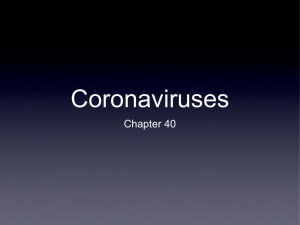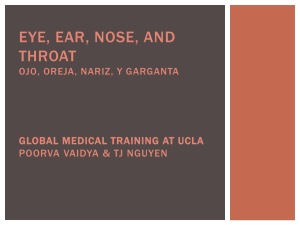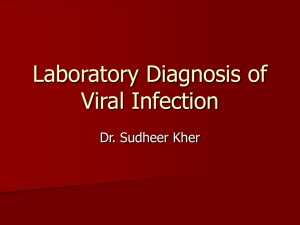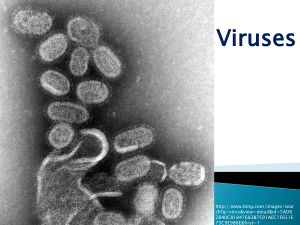08 Pathogenesis of Viral Infection AK
advertisement
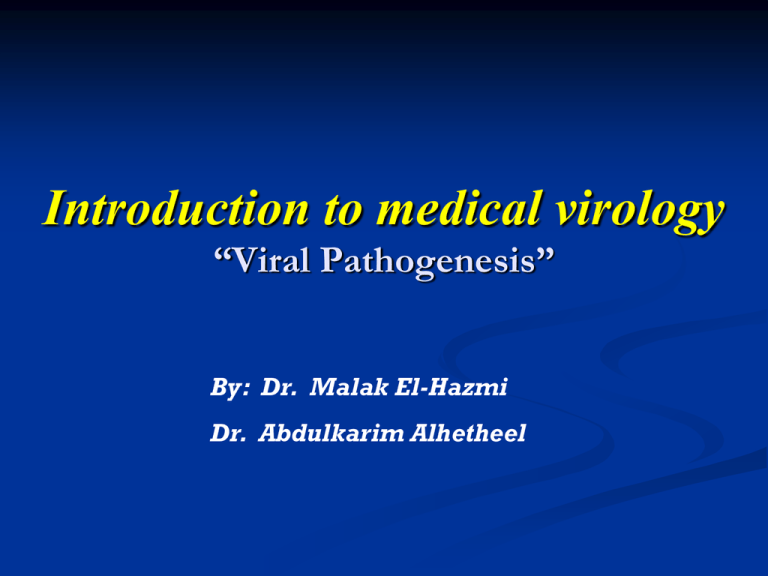
Introduction to medical virology “Viral Pathogenesis” By: Dr. Malak El-Hazmi Dr. Abdulkarim Alhetheel OBJECTIVES • • • • • • Definition and levels of viral pathogenesis. Types of viral infections at cellular level. Pathogenesis at host level. The immune response to viral infection. The stages of viral infection. The types of viral infections at host level. Pathogenesis of viral infection Viral disease at the cellular level Cytopathogenesis Viral disease at the host level Mechanism of the disease Cytopathogenesis: The types of viral infections at cellular level The effects on cells/ Type of Infection Abortive Productive Cytolytic Non-cytolytic [Persistant] Non-productive Latent [ Pt ] Transformation [ Pt ] Virus Production Vs not produced Vs Produced Vs Produced Vs not Produced Viral NA present Viral NA present The types of viral infections at cellular level A) Abortive Infections: Viruses don’t complete the replication cycle Due to mutation, defective interfering particles & the action of IFNs B) Productive Infections: 1. A B Cytolytic Infections Viruses replicate & produce progeny Cell death & Cytopathic effects [CPE] Inhibition of cellular protein & NA synthesis Cytopathic Effects CPE can take several forms: 1. 2. 3. 4. Cell lysis Cell rounding Syncytium formation Inclusion bodies formation Uninfected cc Cell rounding Cyncytium Syncytium formation Herpes paramyxoVs Cc ;Syncytium (RSV) Inclusion bodies formation Site: Intranuclear [Herpes] Intracytoplasmic [Rabies] Take several forms: Single/multiple Small/large Round/irregular Inclusion bodies formation Negri bodies caused by Rabies virus Owl’s eye inclusions caused by CMV The types of viral infections at cellular level B) Productive Infections: 1. Cytolytic Infections 2. Non-cytolytic infections : Viruses replicate & produce progeny Vs released by cell budding & little or no CPE Identified by hemadsorption & direct IF The types of viral infections at cellular level C) Non-productive Infections: Vs infect cells that restrict or lack the machinery for transcribing viral genes. Viral genome is found either integrated into cell DNA or as a circular episome or both. 1) Latent Infection: Persistent infection b/c there is limited expression of viral genes The cell retains its normal properties Ex: HSV 2) Transformation: Ex ; EBV, HPV and HTLV Cause tumor in animals & H and can transform cell culture Vs can stimulate uncontrolled cell growth causing Tf by alternating the balance between growth activators & growth suppressors gene products Cytopathogenesis: The types of viral infections at cellular level The effects on cells/ Type of Infection Abortive Productive Cytolytic Non-cytolytic [Persistant] Non-productive Latent [ Pt ] Transformation [ Pt ] Virus Production Vs not produced Vs Vs Produced Produced Vs not Produced Viral NA present Viral NA present Pathogenesis at Host Level 1. 2. 3. 4. Transmission of the virus & its entry into the host. Replication of the virus & damage to cells Vs remain localized or spread to other organs Viral shedding 5. The immune response as Host defense Immunopathogenesis Transmission 1. Person to person a) Horizontal transmission Skin contact , Blood Respiratory route Fecal - oral route Genital contact b) Vertical transmission 2. Animal to person Common Routes of Human Infection by Viruses Route of Entry Virus Disease (L/G) Mild Trauma HPV Warts (L) Injection (Blood) HBV,HCV, HIV Hepatitis B, Hepatitis C ,AIDS (G) Bite of insect animal Yellow fever virus Rabies virus Yellow fever (G) Rabies (G) Respiratory tract HSV-1 Rhinovirus RSV Adenovirus VZV Measles virus Gingivostomatitis (L) (URT) Common cold (L) (URT) Bronchiolitis (L) (LRT) Pneumonia (L) (LRT) Chickenpox (G) Measles (G) GIT Rotavirus HAV Poliovirus Diarrhea (L) Hepatitis A (G) Poliomyelitis (G) Genital tract HSV-2 Genital herpes (L) Meningitis (G) Encephalitis (G) Hepatitis B (G) AIDS(G) Skin HBV HIV Mechanisms of spread of virus through the body Virus shedding Important features of Acute Viral Diseases Local Infections Systemic Infections Ex. of specific Disease Rhinovirus Measles Site of Pathology Portal of entry Distant site IP Relatively short Relatively long Viremia Absent Present Duration of Immunity Variable- may be short Usually life long Role of Secretory AB [IgA] in resistance Usually important Usually not important The immune response to virus The immune response to virus Macrophages: APC, Phagocytosis, Cytokines production Natural killer (NK) cells : Lysis of VICs Cytokines: Interferons (IFN) α , β IFN inhibit the viral and the host cell mRNA translation γ IFN stimulate phagocytosis and killing by macrophage & NK cells Interleukin (IL) Stimulate AB production Activate T cells & CMI Suppress the IR The immune response to virus The immune response to virus CMI: Effective against intracellular viruses Lysis of virally infected cells by CTCs [CD8] Humoral Immunity: Effective on extracellular viruses [viremia] - Neutralization The stages of a typical viral infection: 1. The incubation period 2. Prodromal period 3. The specific-illness period: The signs & symptoms of viral diseases are the result of Cell killing by: A) Inhibition of cellular macromolecular synthesis B) Immunologic attack ( Immunopathogenesis) Cytotoxic T cells e.g. Hepatitis (HAV, HBV,HCV) 4. The recovery period Types of viral infections at host level: 1. 2. 3. Asymptomatic infection Acute infection Persistent infection Late complication of acute infection Latent infection Chronic infection Reference books &the relevant page numbers Medical Microbiology and Immunology By: Warren Levinson . 10th Edition, 2008. Pages;221-232 Medical Microbiology. By: David Greenwood ,Richard C.B. Slack John F Peutherer and Mike Barer. 17th Edition, 2007. Pages;80,90-92 Lippincott’s Illustrated Reviews: Microbiology By: William A. Strohl ,Harriet Rouse & Bruce D. Fisher 2nd Edition, 2007 . Pages;15-17,242-243. Questions ?
